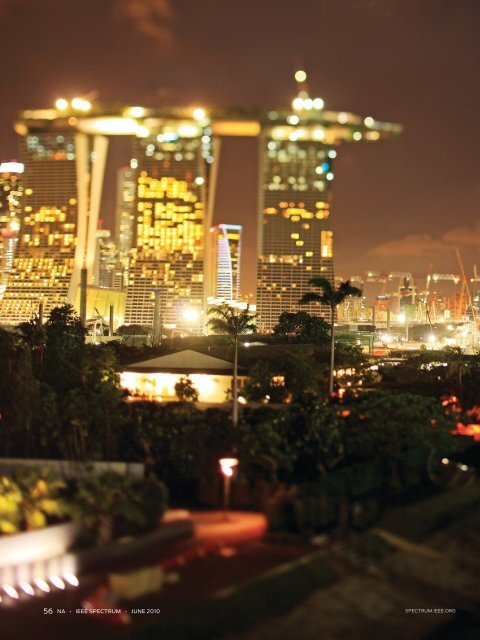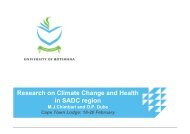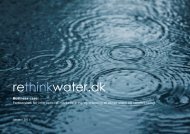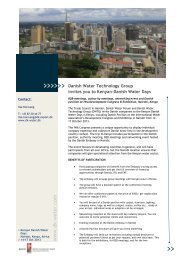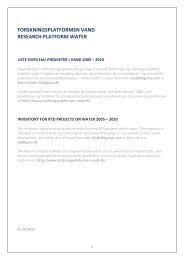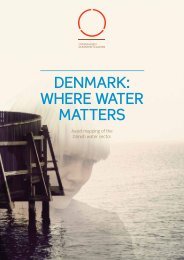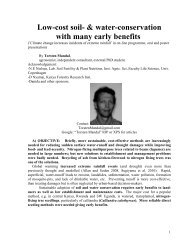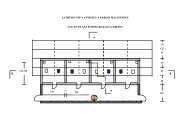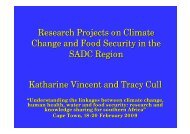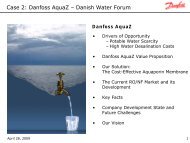Wizards of the water cycle
Wizards of the water cycle
Wizards of the water cycle
- No tags were found...
You also want an ePaper? Increase the reach of your titles
YUMPU automatically turns print PDFs into web optimized ePapers that Google loves.
56 NA • iEEE Spectrum • june 2010 spectrum.ieee.org
S i nga p o r e ’ s s k y l i n eg l e a m s b e h i n d t h em a r i n a r e s e r voi r .T h e n e w ly e n c l o s e db ay i s f l a n k e d b ya t h r e e - p i l l a r e dr e s o rt b u i lt o nr e c l a i m e d l a n d.t i n y t e s t b e d ss i n g a p o r e n m a l t as p e c i a l r e p o r t n w a t e r v s . e n e r g y<strong>Wizards</strong><strong>of</strong> <strong>the</strong>Water CycleSingapore’s toilet-to-taptechnology has saved <strong>the</strong>country from shortages—and a large electricity billb y s a n d r a U p s o np h o t o s b y D a r r e n S o hspectrum.ieee.orgjune 2010 • IEEE Spectrum • NA 57
3. t i n y t e s t b e d s n s i n g a p o r e n d e s a l i n a t i o n n m a l t as i N G a P o r e B e G a N i t s J o U r N e yto sovereignty with a mighty jolt. Theisland was still an exotic outpost <strong>of</strong> <strong>the</strong>British Empire when World War IIdelivered <strong>the</strong> shake-up. Japan’s armywas preparing to invade from <strong>the</strong> MalayPeninsula, and <strong>the</strong> British forces beat aretreat to Singapore across <strong>the</strong> one bridgeconnecting it to <strong>the</strong> mainland. To thwart<strong>the</strong> Japanese troops, <strong>the</strong> Royal Engineersblew up <strong>the</strong> bridge behind <strong>the</strong>m.The blast sealed <strong>the</strong> island’s doom, forit also ruptured a critical pipeline thatbrought <strong>water</strong> from Johor, a Malay state.The people <strong>of</strong> Singapore discovered <strong>the</strong>yhad only a few days’ <strong>water</strong> stored in<strong>the</strong>ir meager reservoirs. The island wastruly defenseless. The Japanese swiftlyrepaired <strong>the</strong> bridge, bi<strong>cycle</strong>d across <strong>the</strong>strait, and claimed victory.Sixty-eight years later, this port cityhas both gained territorial independenceand managed to bootstrap itsway to wealth in spite <strong>of</strong> a lack <strong>of</strong> <strong>water</strong>and energy. And now, against all odds,complete <strong>water</strong> independence—fromboth Malaysia and even <strong>the</strong> wea<strong>the</strong>r—is within easy reach. Ra<strong>the</strong>r than flushingwaste into <strong>the</strong> sea, <strong>the</strong> <strong>water</strong> utilitycollects <strong>the</strong> country’s waste<strong>water</strong>, cleansit to pristine levels, and returns it to <strong>the</strong>public supply. Singapore has thus shortcircuited<strong>the</strong> <strong>water</strong> <strong>cycle</strong> by reducing it toan island-ringing loop.At first, no one relished <strong>the</strong> idea <strong>of</strong>drinking waste<strong>water</strong>. Rejuvenating<strong>the</strong> waste stream requires electricityto power an intensive cleaning process,and that investment makes <strong>the</strong> re<strong>cycle</strong>d<strong>water</strong> more expensive than what’s usedby cities blessed with nearby fresh<strong>water</strong>lakes, rivers, and aquifers. But presentedwith a set <strong>of</strong> tough choices, Singaporechose <strong>water</strong> recycling—and so far it hasworked admirably.W h e N S i N g a P o r e F i N a l ly S e Pa r at e dfrom Britain and <strong>the</strong>n Malaysia in <strong>the</strong>1960s, <strong>water</strong> was at <strong>the</strong> top <strong>of</strong> <strong>the</strong> agenda.The government negotiated two treatieswith its mainland neighbor to guarantee a<strong>water</strong> supply, at a cost, for <strong>the</strong> next century.With a base supply in place, <strong>the</strong> <strong>water</strong>utility went looking for more. The agencystarted with <strong>the</strong> one resource availabler e v e r S e - o S m o S i Sm e m b r a n e Sat a n e wat e rp l a n t, ov e r S e e nb y h a r r y S e a h[ t op r ight ] , p r o d u c et h e n e wat e r S a m p l e db y c h i l d r e n.to this tropical dollop <strong>of</strong> land, its amplerainfall—some 237 centimeters a year.It built dams to interrupt <strong>the</strong> flow <strong>of</strong> itsstreams and tiny rivers and built 15 reservoirsto store rain. Such reservoirsare crucial because <strong>the</strong>y stand in for <strong>the</strong>ground<strong>water</strong> that Singapore lacks.Then <strong>the</strong> utility did a radical thing.After half a decade <strong>of</strong> research and tests ata pilot recycling plant, Singapore’s plannersunveiled <strong>the</strong>ir ultimate strategy for<strong>water</strong> security. They would force waste<strong>water</strong>through filters under high pressureto remove all microbes, viruses, andlarger impurities. The utility called itsproduct NEWater, and it called <strong>the</strong> treatmentplant a factory. With great emphasison its sparkling newness, treatedwaste<strong>water</strong> made its public debut in 2003.The real work was about to start. Oneby one, <strong>the</strong> utility cajoled its customersinto accepting <strong>the</strong> <strong>water</strong>. Manufacturerswondered what residues <strong>the</strong> <strong>water</strong> mightNEWaterTASTETESTthree choices: NeWater,bottled <strong>water</strong> fromMalaysia, and a glass filled at<strong>the</strong> tap. your correspondentsat down to drink. <strong>the</strong>NeWater was bland toa fault, like paper madepotable. <strong>the</strong> Malaysian<strong>water</strong> delivered a cloying aftertaste—a perplexingblend <strong>of</strong> dryer lint and berries. <strong>the</strong> drink from <strong>the</strong>tap, however, was just right.leave in <strong>the</strong>ir factories, but Harry Seah, <strong>the</strong>utility’s director <strong>of</strong> technology and <strong>water</strong>quality, pointed out that NEWater wascleaner than most drinking <strong>water</strong>. “At firstI had to convince <strong>the</strong>m,” Seah recalls. Butsoon enough, he had signed on <strong>the</strong> island’s12 wafer-fabrication plants and o<strong>the</strong>r electronicsmanufacturers, and <strong>the</strong> utilitylaid dedicated pipes to deliver NEWater.Now Systems on Silicon ManufacturingCo., which uses ultrapure <strong>water</strong> to washits silicon wafers, champions NEWater.58 nA • ieee spectrum • june 2010 spectrum.ieee.org
s p e c i a l r e p o r t n w a t e r v s. e n e r g yThe company calculated that <strong>the</strong> re<strong>cycle</strong>d<strong>water</strong>’s exceeding purity saves it morethan half a million dollars a year, in partby cutting out steps in its internal <strong>water</strong>purificationprocess.Singapore also started priming <strong>the</strong>public. The prime minister drank a bottle<strong>of</strong> NEWater at a national festival, and<strong>the</strong> crowd cheered. The subtext wasclear—patriotic Singaporeans drinkwaste<strong>water</strong>. But <strong>the</strong> rest <strong>of</strong> Singaporewas slower to follow. A parody <strong>of</strong> a popularnationalist song, “Count on Me,Singapore,” cheerily urged residents to“Drink Our Pee, Singapore.”T he queasy reac t ions <strong>of</strong> someSingaporeans didn’t deter <strong>the</strong> utility,which built four more waste<strong>water</strong> treatmentplants and is about to increase itsNEWater production to 555 megalitersa day. By <strong>the</strong> end <strong>of</strong> this year <strong>the</strong> plantswill treat enough sewage to cover nearlya third <strong>of</strong> Singapore’s <strong>water</strong> needs.spectrum.ieee.orgFor now, only a tiny fraction <strong>of</strong> <strong>the</strong>drinking supply is NEWater. About40 ML are blended in with <strong>the</strong> city-state’spotable <strong>water</strong> each day, equivalent to2 percent <strong>of</strong> consumption. The utility alsobuilt a sea<strong>water</strong> desalination plant thatproduces 136 ML <strong>of</strong> <strong>water</strong> each day, or a bitless than one-tenth <strong>of</strong> Singapore’s supply.The city-state has all <strong>the</strong> <strong>water</strong> it needs.N at u r e ’ s h y d r o l o g i c a l c y c l e r e l i e son sunlight to evaporate <strong>water</strong>, leavingbehind salt and o<strong>the</strong>r impuritiesand returning fresh<strong>water</strong> to Earth in<strong>the</strong> form <strong>of</strong> rain and snow. But it can becapricious: Most fresh<strong>water</strong> evaporatesfrom <strong>the</strong> oceans, where it rises through<strong>the</strong> atmosphere and <strong>the</strong>n cools to formclouds. Winds push around <strong>the</strong> clouds,driving a few <strong>of</strong> <strong>the</strong>m over land, where<strong>the</strong>y deposit a mere tenth <strong>of</strong> <strong>the</strong> world’sprecipitation, according to <strong>the</strong> U.S.Geological Survey. Singapore decided tocut <strong>the</strong> atmosphere out <strong>of</strong> <strong>the</strong> transactionand to replace evaporation with speediermechanisms—membranes.Here’s how it works: First, a treatmentplant ga<strong>the</strong>rs up <strong>the</strong> city’s used <strong>water</strong> andseparates out <strong>the</strong> large, easily removableimpurities. About 60 percent <strong>of</strong> <strong>the</strong> <strong>water</strong>is released into <strong>the</strong> sea. The rest gets sentto a NEWater factory. The <strong>water</strong> enterscontaminated with bacteria, viruses, andall sorts <strong>of</strong> carbon-based particles andemerges cleaner than what flows fromjust about any tap in <strong>the</strong> world.The main tactic <strong>of</strong> <strong>the</strong> <strong>water</strong> trade isto simply push <strong>water</strong> through tiny holes—<strong>the</strong> smaller <strong>the</strong> holes, <strong>the</strong> fewer <strong>the</strong> undesirablemolecules that can sneak through.The art is to do so without sending <strong>the</strong>electricity bill skyrocketing or cloggingup <strong>the</strong> tiny holes with grime. Here, <strong>the</strong>first step is to force <strong>the</strong> <strong>water</strong> through amembrane that blocks particles <strong>of</strong> up to0.2 micrometers in size, catching mostbacteria and protozoa. The membranelooks like a cylinder filled with skinny,hollow tubes. The stream flows into <strong>the</strong>porous straws. Water molecules pushthrough <strong>the</strong> pores and collect outside<strong>the</strong> membranes, while <strong>the</strong> larger particlescontinue traveling inside <strong>the</strong> tubes,to be disposed <strong>of</strong> separately.The <strong>water</strong> still needs to be stripped<strong>of</strong> any viruses that might be adrift in <strong>the</strong>flow. For this <strong>the</strong> partially treated streamneeds a reverse-osmosis membrane. Inone configuration, paperlike sheets <strong>of</strong>membrane more than a meter long aresandwiched between sheets called spacers.The stack <strong>of</strong> membranes and spacersis wound up into a cylinder, like a thickroll <strong>of</strong> wrapping paper. The core <strong>of</strong> <strong>the</strong>cylinder is an empty channel where <strong>the</strong>clean <strong>water</strong> collects.As <strong>the</strong> stream is pushed into one end<strong>of</strong> <strong>the</strong> roll, <strong>the</strong> impurities slide along <strong>the</strong>spacers and never penetrate <strong>the</strong> polymermembrane. The <strong>water</strong> molecules, however,escape through <strong>the</strong> 0.0001-µm poresand slip into <strong>the</strong> central channel.These two steps remove just abouteverything, but in a third and final step,mercury lamps generate ultraviolet-lightrays that penetrate <strong>the</strong> <strong>water</strong>. The radiationscrambles <strong>the</strong> genetic material <strong>of</strong> anybacteria and o<strong>the</strong>r microorganisms thatjune 2010 • IEEE Spectrum • NA 59
3. t i n y t e s t b e d s n s i n g a p o r e n d e s a l i n a t i o n n m a l t aglacier or how much rain falls duringmonsoon season. Suddenly, Singapore is<strong>water</strong> rich. The <strong>water</strong> that falls from <strong>the</strong>sky may have once washed <strong>the</strong> streets <strong>of</strong>Paris or filled Cleopatra’s bathtub. Nowit’s augmented with some <strong>of</strong> <strong>the</strong> <strong>water</strong>used by Harry Seah, Asit Biswas, andeverybody else in Singapore. The utilityisn’t waiting for nature to turn its used<strong>water</strong> fresh again—it’s letting technologydo <strong>the</strong> job.might have slipped through, destroying<strong>the</strong>ir ability to reproduce. Now <strong>the</strong> <strong>water</strong>is ready for <strong>the</strong> tap.t h e S i g N i F i c a N c e o F N e Wat e r i S M u c hgreater than its literal contribution indrops or buckets or liters per person.“NEWater is key to our whole strategy,”Seah says.Seah is a s<strong>of</strong>t-spoken, dapper manwith a face that collapses frequentlyinto a brassy laugh. He’s been with <strong>the</strong>Public Utilities Board for almost twodecades, and he’s seen <strong>the</strong> NEWaterproject through to maturity. “The realbeauty <strong>of</strong> NEWater is its multiplyingeffect,” he explains. What he means isthat if <strong>the</strong> utility re<strong>cycle</strong>s 50 percent <strong>of</strong>its waste<strong>water</strong>, Singapore can squeezeone more drop out <strong>of</strong> every two it desalinatesor collects from <strong>the</strong> sky. “If I canachieve 100 percent recycling, I wouldn’teven need rain,” Seah says.That’s critical, given how few optionsSingapore has. Half <strong>of</strong> <strong>the</strong> island hasalready been converted into rain<strong>water</strong>catchment areas, and three new reservoirswill soon bring it to two-thirds. Theo<strong>the</strong>r source <strong>of</strong> fresh<strong>water</strong> is Singapore’sone desalination plant, which consumesso much energy it can cover only a fraction<strong>of</strong> <strong>the</strong> overall demand.Consider <strong>the</strong> details. To remove saltfrom sea<strong>water</strong>, Seah says <strong>the</strong> treatmentplant must apply a pressure <strong>of</strong> about7 megapascals. To remove impuritiest h e m a r i n ab a r r age t u r n Sa b ay i n t o ar e S e r voi r[at le f t ]p r o t e c t e d f r o mt h e S e a [ r ight ] .from waste<strong>water</strong>, he requires less than1 MPa. That translates directly into <strong>the</strong>energy cost for <strong>the</strong> whole plant—morethan 4 kilowatt-hours per thousand liters<strong>of</strong> <strong>water</strong> for sea<strong>water</strong> desalination, versus0.7 kWh for NEWater. “It’s a no-brainer,”says Seah, and his eyes crinkle into alaugh. “Win, win, win!” he says.Asit Biswas, an international <strong>water</strong>policyexper t who splits his timebetween <strong>the</strong> National University <strong>of</strong>Singapore and <strong>the</strong> Third World Centerfor Water Management, in Mexico, seesSingapore as one <strong>of</strong> <strong>the</strong> few places where<strong>the</strong> <strong>water</strong> authorities agree with his owncontroversial position—that <strong>water</strong> scarcitysimply does not exist. What doesexist, just about everywhere, is bad<strong>water</strong> management.The problem, he says, is that peopletend to assume that <strong>water</strong> is like oil orany o<strong>the</strong>r fossil fuel and that it behavesaccording to <strong>the</strong> same basic economicprinciples. “But <strong>water</strong> is not oil,” hesays. “Once we use oil, it breaks downinto various components. You can’tput it back toge<strong>the</strong>r.” Water, despiteits tendency to evaporate and trickleout <strong>of</strong> reach, doesn’t change its molecularstructure. “There is no limit tohow many times <strong>water</strong> can be reused,”Biswas points out.That simple fact radically changes <strong>the</strong>way that <strong>water</strong> is counted. What’s availableto a city or country is not just a matter<strong>of</strong> how much ice sits in a HimalayanN o t e V e r y o N e c a N B e c a J o l e d i N t odrinking re<strong>cycle</strong>d urine. In Queensland,Australia, and in San Diego, public opinionhas thwarted local utilities’ <strong>water</strong>-recyclingambitions. But at least three sitesin <strong>the</strong> United States—Scottsdale, Ariz.;Orange County, Calif.; and nor<strong>the</strong>rnVirginia—purify waste<strong>water</strong> and blend itinto <strong>the</strong>ir drinking <strong>water</strong>.In fact, most places reuse <strong>water</strong>—justwithout meaning to do so. According toPeter Gleick’s The World’s Water 2002–2003, each drop in <strong>the</strong> Colorado Riveris used 17 times. Similarly, residents <strong>of</strong>London drink <strong>water</strong> that was dischargedfrom numerous waste<strong>water</strong> treatmentplants upstream on <strong>the</strong> Thames.In Singapore’s case, <strong>the</strong> deliberatereuse <strong>of</strong> <strong>water</strong> has played a prominentrole in <strong>the</strong> country’s development.Seetharam Kallidaikurichi is <strong>the</strong> director<strong>of</strong> <strong>the</strong> Institute <strong>of</strong> Water Policy at <strong>the</strong>National University <strong>of</strong> Singapore, and heargues that Singapore’s <strong>water</strong> strategyhas been <strong>the</strong> foundation <strong>of</strong> <strong>the</strong> country’seconomic success in <strong>the</strong> last 45 years.“The evidence is beginning to emerge,”he says, “that it’s not <strong>water</strong> among manyo<strong>the</strong>r things but <strong>water</strong> as central, <strong>the</strong> keyto unlocking <strong>the</strong> vicious <strong>cycle</strong>s <strong>of</strong> deprivationand poverty into economic successand a good quality <strong>of</strong> life.”But prioritizing <strong>water</strong> means using aconsiderable amount <strong>of</strong> energy to makeit, clean it, and move it. The question ishow to optimize <strong>the</strong> juggle <strong>of</strong> resources.Because Singapore must import some290 billion cubic feet <strong>of</strong> natural gas to runits power plants, it can be said that <strong>the</strong>country has merely substituted one form<strong>of</strong> dependence for ano<strong>the</strong>r.The consequences <strong>of</strong> that dependenceare starting to hit home. Darren60 nA • ieee spectrum • june 2010 spectrum.ieee.org
s p e c i a l r e p o r t n w a t e r v s. e n e r g yILLUSTRATION: BRANDON PALACIO; MAP: ANDREW ZBIHLYJSun, an associate pr<strong>of</strong>essor <strong>of</strong> civil andenvironmental engineering at NanyangTechnological University, in Singapore,has seen an uptick in interest in his workon energy-efficient membranes. “In most<strong>water</strong> engineering, people didn’t careabout how much energy goes in—untilrecently. The energy crisis made thisa critical issue,” he says. Sun is investigatinga membrane design that usestitanium-dioxide nan<strong>of</strong>ibers to filter <strong>water</strong>and generate electricity simultaneously.But <strong>the</strong> research is far from mature,so for now <strong>the</strong> energy cost will remainhigh. That’s <strong>the</strong> price Singapore mustpay for a first-rate <strong>water</strong> supply and ahealthy country, says Kallidaikurichi.“You may argue that <strong>water</strong> here consumesmore energy, but <strong>the</strong> city needsmore <strong>water</strong>, because it’s <strong>the</strong> city that’sproducing more wealth.”The solution to making <strong>the</strong> trade-<strong>of</strong>fwork, say Biswas and Kallidaikurichi, ispurely economic: Singapore charges allits customers <strong>the</strong> marginal cost <strong>of</strong> <strong>water</strong>—that is, <strong>the</strong> cost <strong>of</strong> producing ano<strong>the</strong>r liter.For Singapore, that means desalination.So <strong>the</strong> Public Utilities Board has set<strong>the</strong> price <strong>of</strong> <strong>water</strong> to pay for its energyintensiveoperations.As a result, <strong>the</strong> utility has enough cashto investigate new technologies. Seahwould like to cut <strong>the</strong> energy needed fordesalination by more than half, to 1.5 kWhper thousand liters, and <strong>the</strong> energy forNEWater to 0.4 kWh from 0.7 kWh.He ’s opt i m ist ic. A f ter a l l, t heNEWater processes would have consumedmore energy per liter had hisengineers not experimented with <strong>the</strong>m.“The technologies came from everywhere,but I think our value is in how weexploit <strong>the</strong>m,” Seah says. “How we put<strong>the</strong>m toge<strong>the</strong>r. How we wrote <strong>the</strong> s<strong>of</strong>tware.How we operate <strong>the</strong> plants.”For example, he and his colleaguesfound a way to introduce a bit <strong>of</strong> chloramine,a disinfectant, into <strong>the</strong> membranefi lt r at ion pro cess. T hat add it ionprevents <strong>the</strong> pores from clogging withoutdegrading <strong>the</strong> membrane material—achallenge that had stymied <strong>the</strong>industry for some time. Clogged poresmean more pressure to drive <strong>the</strong> <strong>water</strong>through, with a larger electricity bill asa result. Similarly, <strong>the</strong> utility’s engineershave found a way to use less pressurein operating a membrane bioreactor, amachine containing swarms <strong>of</strong> microorganismsthat snack on contaminantsin <strong>the</strong> <strong>water</strong>. That innovation will soonreplace <strong>the</strong> first filtration step, makingNEWater about 20 percent cheaper toproduce, Seah says.O<strong>the</strong>r innovations are likely to trickleout <strong>of</strong> Singapore’s <strong>water</strong> sector, as companiesand academics seek to pr<strong>of</strong>itfrom <strong>the</strong> <strong>water</strong> utility’s interest in innovation.For example, researchers underSay Leong Ong, acting head <strong>of</strong> <strong>the</strong> environmentalsciences and engineeringdivision at <strong>the</strong> National University <strong>of</strong>Singapore, are figuring out <strong>the</strong> mechanismsused by mangrove trees andtilapia fish to process <strong>the</strong> salt in sea<strong>water</strong>,with <strong>the</strong> hope <strong>of</strong> one day designingmembranes that mimic nature.Ultimately, Singapore will have true<strong>water</strong> security only if it can reduce itsdependence on imported energy. A civilization’ssurplus energy, arising fromits trade and technological prowess, isReservoirsNEWater Plant77 ML/dayWater importedfrom MalaysiaPoweredByCrazyFree eNergy? uriNe lucK!you may not think <strong>of</strong> urine as avaluable resource—quite <strong>the</strong>opposite, probably—but ohiouniversity chemical engineergerardine Botte has come upwith a way to harness it forgood. Botte’s technologyefficiently produceshydrogen for fuel-cellpoweredcars, from urine.dry out that urine and you’re left with acompound called urea, a single molecule <strong>of</strong>which contains four hydrogen atoms. <strong>the</strong>bonds that bind urea’s hydrogen are mucheasier to break than <strong>the</strong> hydrogen bonds in<strong>water</strong>, which is typically used as <strong>the</strong> sourcefor hydrogen in fuel cells. experimentingwith human urine, Botte showed thatapplying a mere 0.37 volt did <strong>the</strong> trick,much less than <strong>the</strong> 1.23 V required to split<strong>water</strong>. What’s more, urea yields twice asmuch hydrogen per molecule.Botte’s research might lead to cheaperhydrogen for fuel cells as well as cheaperwaste<strong>water</strong> purification: a scaled-up version<strong>of</strong> <strong>the</strong> technology could generate hydrogenwhile treating sewage.—Sally Adeewhat allows an economy to shift investmentaway from life-critical needs such as<strong>water</strong> to education, art, and a rich civic life.An energy-secure <strong>water</strong> sector, <strong>the</strong>n, willbe a major question for <strong>the</strong> next 50 years<strong>of</strong> <strong>the</strong> tiny island’s nationhood. ❏NEWater Plant23 ML/dayPacificO ceanI n d I aArea <strong>of</strong>detailC h I n aNOT JUSTTOILETS...NEWaterplants andreservoirsdot <strong>the</strong> island, providing anengineered stand-in for <strong>the</strong>ground<strong>water</strong> Singapore lacks.DesalinationPlantSouth TunnelSewerage System(incomplete)NEWater Plant145 ML/dayNorth TunnelSewerage SystemNEWater Plant82 ML/dayNEWater Plant227 ML/dayspectrum.ieee.orgieee spectrum • nA 61


